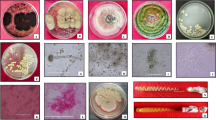Abstract
Despite indications that S. granulatus and S. luteus release iron-chelating compounds, the exact spectrum of ferric hydroxamates synthesized by these two Suillus species remained unclear. Hence the aim of this study was to identify all of the main siderophores produced by these two ectomycorrhizal fungal species under pure culture conditions. By means of HPLC and LC–MS analyses we show that S. granulatus releases cyclic and linear fusigen, ferrichrome, coprogen and triacetylfusarinine C into the nutrient medium, while S. luteus culture filtrates contain cyclic and linear fusigen, ferricrocin and coprogen. All of the different siderophores were identified on basis of reference compounds and their specific MS spectra which were recorded on a high resolution MS in positive electrospray ionisation mode. Initial HPLC separations were performed on a C-18 stationary phase, using an acidic eluent (0.1% formic acid in water and acetonitrile) in gradient mode. The potential of these two ectomycorrhizal fungal species to produce siderophores representing three different groups of hydroxamates is discussed in relation to its ecological significance.


Similar content being viewed by others
References
Blume HP, Brümmer GW, Schwertmann U, Horn R, Kögel-Knabner I, Stahr K, Auerswald K, Beyer L, Hartmann A, Litz N, Scheinost A, Stanjek H, Welp G, Wilke BM (2002) Lehrbuch der Bodenkunde. Spektrum Akademischer Verlag, Heidelberg
Buss HL, Lüttge A, Brantley SL (2007) Etch pit formation on iron silicates during siderophore-promoted dissolution. Chem Geol 240:326–342
Courty PE, Buée M, Diedhiou AD, Frey-Klett P, Le Tacon F, Rineau F, Turpault MP, Uroz S, Garbaye J (2010) The role of ectomycorrhizal communities in forest ecosystem processes: new perspectives and emerging concepts. Soil Biol Biochem 42:679–698
Dahlberg A, Finlay RD (1999) Suillus. In: Cairney JWG, Chambers SM (eds) Ectomycorrhizal fungi. Springer, Berlin, pp 33–64
Essen SA, Bylund D, Holmström SJM, Moberg M, Lundström US (2006) Quantification of hydroxamate siderophores in soil solutions of podzolic soil profiles in Sweden. Biometals 19:269–282
Haselwandter K (2008) Structure and function of siderophores produced by mycorrhizal fungi. Mineral Mag 72:61–64
Haselwandter K, Winkelmann G (2002) Ferricrocin: an ectomycorrhizal siderophore of Cenococcum geophilum. Biometals 15:73–77
Haselwandter K, Winkelmann G (2007) Siderophores of symbiotic fungi. In: Chincholkar SB, Varma A (eds) Microbial siderophores. Soil biology series, vol 12. Springer, Berlin, pp 91–103
Haselwandter K, Winkelmann G (2009) Siderophores of mycorrhizal fungi: detection, isolation and identification. In: Varma A, Kharkwal AC (eds) Symbiotic fungi. Soil biology series, vol 18. Springer, Berlin, pp 393–402
Hoffland E, Kuyper TW, Wallander H, Plassard C, Gorbushina AA, Haselwandter K, Holmström S, Landeweert R, Lundström US, Rosling A, Sen R, Smits MM, van Hees PAW, van Breemen N (2004) The role of fungi in weathering. Front Ecol Environ 2:258–264
Konetschny-Rapp S, Huschka HG, Winkelmann G, Jung G (1988) High-performance liquid chromatography of siderophores from fungi. Biometals 1:9–17
Kretzer A, Li Y, Szaro T, Bruns TD (1996) Internal transcribed spacer sequences from 38 recognized species of Suillus sensu lato: phylogenetic and taxonomic implications. Mycologia 88:776–785
Leyval C, Watteau F, Berthelin J, Reid CPPP (1992) Production of siderophores by ectomycorrhizal fungi. In: Read DJ, Lewis DH, Fitter AH, Alexander IJ (eds) Mycorrhizas in ecosystems. CAB International, Wallingford, pp 389–390
Machuca A, Pereira G, Aguiar A, Milagres AMF (2006) Metal-chelating compounds produced by ectomycorrhizal fungi collected from pine plantations. Lett Appl Microbiol 44:7–12
Moberg M, Holmström SJM, Lundström US, Markides KE (2003) Novel approach to the determination of structurally similar hydroxamate siderophores by column-switching capillary liquid chromatography coupled to mass spectrometry. J Chromatogr A 1020:91–97
Molina R, Massicotte H, Trappe JM (1992) Specificity phenomena in mycorrhizal symbioses: community-ecological consequences and practical implications. In: Allen MF (ed) Mycorrhizal functioning. Chapman & Hall, New York, pp 357–423
Nannipieri P, Kandeler E, Ruggiero P (2002) Enzyme activities and microbiological and biochemical processes in soil. In: Burns RG, Dick RP (eds) Enzymes in the environment: activity, ecology, and applications. Dekker, New York, pp 1–33
Pierwola A, Krupinski T, Zalupski P, Chiarelli M, Castignetti D (2004) Degradation pathway and generation of monohydroxamic acids from the trihydroxamate siderophore deferrioxamine B. Appl Environ Microb 70:831–836
Powell PE, Cline GR, Reid CPP, Szaniszlo PJ (1980) Occurrence of hydroxamate siderophore iron chelators in soils. Nature 287:833–834
Reichard PU, Kretzschmar R, Kraemer SM (2007) Dissolution mechanisms of goethite in the presence of siderophores and organic acids. Geochim Cosmochim Acta 71:5635–5650
Szaniszlo PJ, Powell PE, Reid CPP, Cline GR (1981) Production of hydroxamate siderophore iron chelators by ectomycorrhizal fungi. Mycologia 73:1158–1174
van Hees PAW, Rosling A, Essen S, Godbold DL, Jones DL, Finlay RD (2006) Oxalate and ferricrocin exudation by the extramatrical mycelium of an ectomycorrhizal fungus in symbiosis with Pinus sylvestris. New Phytol 169:367–377
Warren RAJ, Neilands JB (1964) Microbial degradation of the ferrichrome compounds. J Gen Microbiol 35:459–470
Watteau F, Berthelin J (1994) Mineral dissolution of iron and aluminium from soil minerals: efficiency and specificity of hydroxamate siderophores compared to aliphatic acids. Eur J Soil Biol 30:1–9
Winkelmann G (2007) Ecology of siderophores with special reference to the fungi. Biometals 20:379–392
Winkelmann G, Busch B, Hartmann A, Kirchhof G, Süßmuth R, Jung G (1999) Degradation of desferrioxamines by Azospirillum irakense: assignment of metabolites by HPLC/electrospray mass spectrometry. Biometals 12:255–264
Acknowledgment
Strain DOM of Suillus granulatus (L. ex Fr.) O. Kuntze was kindly provided by F. Martin, INRA-Nancy, F-54280 Champenoux.
Author information
Authors and Affiliations
Corresponding author
Rights and permissions
About this article
Cite this article
Haselwandter, K., Häninger, G. & Ganzera, M. Hydroxamate siderophores of the ectomycorrhizal fungi Suillus granulatus and S. luteus . Biometals 24, 153–157 (2011). https://doi.org/10.1007/s10534-010-9383-4
Received:
Accepted:
Published:
Issue Date:
DOI: https://doi.org/10.1007/s10534-010-9383-4




